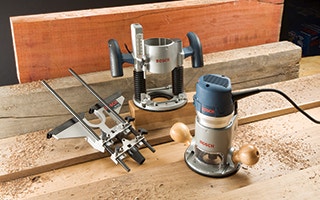A Fixed Base or A Plunge Base Router - Which Should You Buy?
When starting out as a woodworker or when you are setting up a new workshop the router is one of the first tools people invest in. This is because in the power tool world, routers are as versatile as they come. A plunge router and a fixed based router are the two most common styles. Which is best for woodworking? Let's find out.
First, let’s make sure everyone is understands the difference between the two. With a fixed base router, the position of the router bit is constant. In other words, if you set a fixed base router at a cut depth of 1/4", the router bit protrudes past the base 1/4" until you change the depth.
A plunge base router is designed so that you can preset the cut depth and then lower (“plunge”) the bit into the cut with the router’s base flat on the surface of the material. Which one should you buy? Woodworker’s Journal editor Rob Johnstone and woodworking author Michael Dresdner offer a few words of advice:
Customer Question. I'm looking to get my first router, and have noticed several offered with both fixed and plunge bases. Do I need both? Which is used most often? I just plan to do a few miscellaneous home improvement projects."
Rob Johnstone - "If you're truly only going to do a few home improvements, go with the plunge base. You'll have more options and you can always lock it so it acts like a fixed base router."
Michael Dresdner - "The question is not do you need both now, but will you at some point in the future. My bet would be yes. Kits with both fixed and plunge bases are a great way to get a lot of versatility in just one router purchase. I'd definitely go that route."
Keep the inspiration coming!
Subscribe to our newsletter for more woodworking tips and tricks


